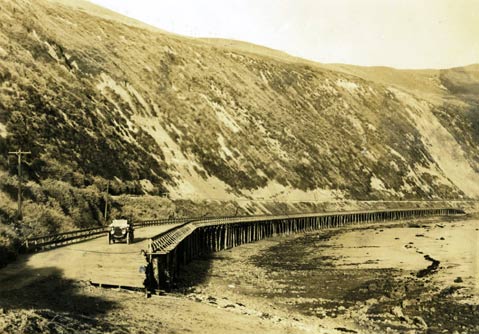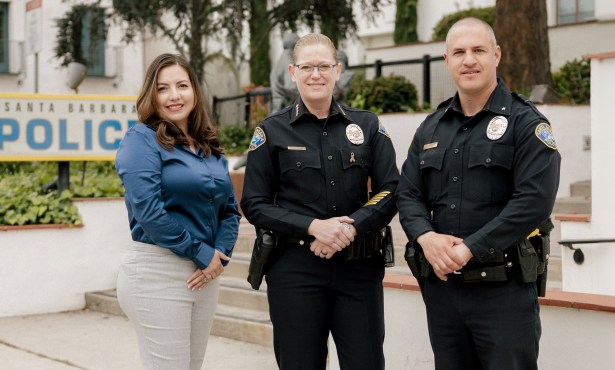Rincon Point Road
Auto Popularity Requires Road Built at Rincon Point

For a good part of its history, getting to Santa Barbara for overland travelers was not all that easy. The city is hemmed in by mountains that meet the Pacific at Gaviota Pass and the Rincon, respectively. In addition, the few passes over the Santa Ynez Range could be difficult, if not downright treacherous. The tremendous growth in the popularity of the automobile in the first decade of the 1900s spurred a movement to construct a decent road in the area around Rincon Point.
Before the completion of the Casitas Pass road in 1878, stagecoaches coming to Santa Barbara from Los Angeles had to take to the beach in the Rincon area. High tides, storms, mud, or rock slides could render this route impassable for even weeks at a time. Although this situation was eased somewhat after the Southern Pacific cut its roadbed into the Rincon hillside as it laid track toward Santa Barbara in 1886, the area remained a dangerous bottleneck.
Even though the troublesome Rincon stretch was in Ventura County, a group from Santa Barbara incorporated in 1910 to construct a private road at a cost of $200,000. The Rincon Toll Company proposed to build a macadam route through the area. Problems over rights of way and the cool reception given the project by the Ventura County supervisors eventually killed the proposal.
Another road campaign gathered momentum in 1911, this one to build a road through public subscriptions. Eighty percent of the needed $50,000 was raised in this manner, with the State Highway Commission putting up the balance. Most of the money was to go toward constructing three raised wooden causeways over the high-tide areas of the beach in the Rincon region. The longest causeway was to be 4,400 feet long.
Construction of these wooden roads, to a total of 7,000 feet, began in November 1911. Contractor John Williamson proposed the use of eucalyptus pilings, which would better withstand the erosive effects of sand and sea. Williamson completed the work on the causeways at a cost of $6.50 per foot. In October 1912, the first automobiles drove over the newly minted roadway. In November, the route was turned over to the State Highway Commission, and the causeways opened to public traffic. Although the Commission planned to include the coast route in its new highway system, for the time being, Ventura County maintained this section of road. A motorist could now travel from Ventura to Santa Barbara in about 90 minutes; the stagecoach had taken some eight hours.
In late November, a celebratory barbecue attended by more than 2,000 people was held at the Rincon. An automobile caravan snaked its way down from Santa Barbara to the barbecue site.
Problems soon cropped up. After about a year, nails protruding from the plank surfaces were causing numerous blowouts. Despite this danger, speeding became so chronic that motorists coined the phrase “the Rincon gait.” Cars flew along at up to 45 miles an hour, and, guard rails notwithstanding, accidents occurred with alarming frequency. Matters were not helped by the proliferation of billboards along the route, which obstructed sight lines. Maintenance was sporadic, and the Automobile Club of Southern California periodically recommended its members use the Casitas Pass road instead of the coastal route.
Nonetheless, the wooden causeways were a vast improvement from the stagecoach era and reflected steady growth in automobile traffic in Southern California. The causeways passed into automotive history in 1924, replaced by a paved road laid upon earth fill.



